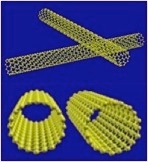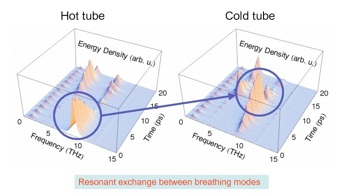Nanomechanical


Nano Electro Mechanical (NEMS) devices include nanoscale resonators that can be used for ultra-sensitive chemical detection, and for low powered wireless communications and signal processing. The key to the operation of these devices is their extremely small size (which enables then to have very high resonant frequencies), and the ability to both excite and detect the resonators electrically.

In our research we aim to build an understanding of the fundamental science of vibrations, heat flow, and dissipation of vibrational energy at these length scales. We then use theory and computer simulation to apply this insight to studying the operation and limits of specific novel NEMS devices. For more information, see P. A. Greaney and J. C. Grossman, “Nanomechanical energy transfer and resonance effects in single-walled carbon nanotubes,” Phys. Rev. Lett. 98, 125503 (2007).
Mechanical Energy Dissipation in Carbon Nanotubes
A substantial body of literature has already been written regarding energy dissipation at the micro and nanoscale. This ancient – but still puzzling – problem has nowadays regained a lot of interest since it has been appointed as the physical phenomena ultimately limiting the performances of NEMS.

It is therefore necessary to get insights on how energy dissipation occurs in such systems and if it can be somehow prevented or reduced, in order for CNTs based oscillators to overtake “older” Si-based oscillators (where Qs are around 10,000) becoming highly performing mass sensors.
By means of classical MD simulations we are currently investigating pristine and defective SWCNTs, to determine the ruling mechanism of energy dissipation in such structures when plucked.
Our results show that dissipation exhibits two regimes strongly depending on the background temperature. Particularly at low temperatures an initial transient region is displayed during which there is little damping: an increase in the duration of this region could be, for example, one route for engineering higher Q factors NEMS resonators.


Energy Exchange and Dissipation
Home / Research / Nanomechanical Phenomena / Energy Transfer
Massachusetts Institute of Technology, 77 Massachusetts Avenue, Cambridge MA 02139-4307

